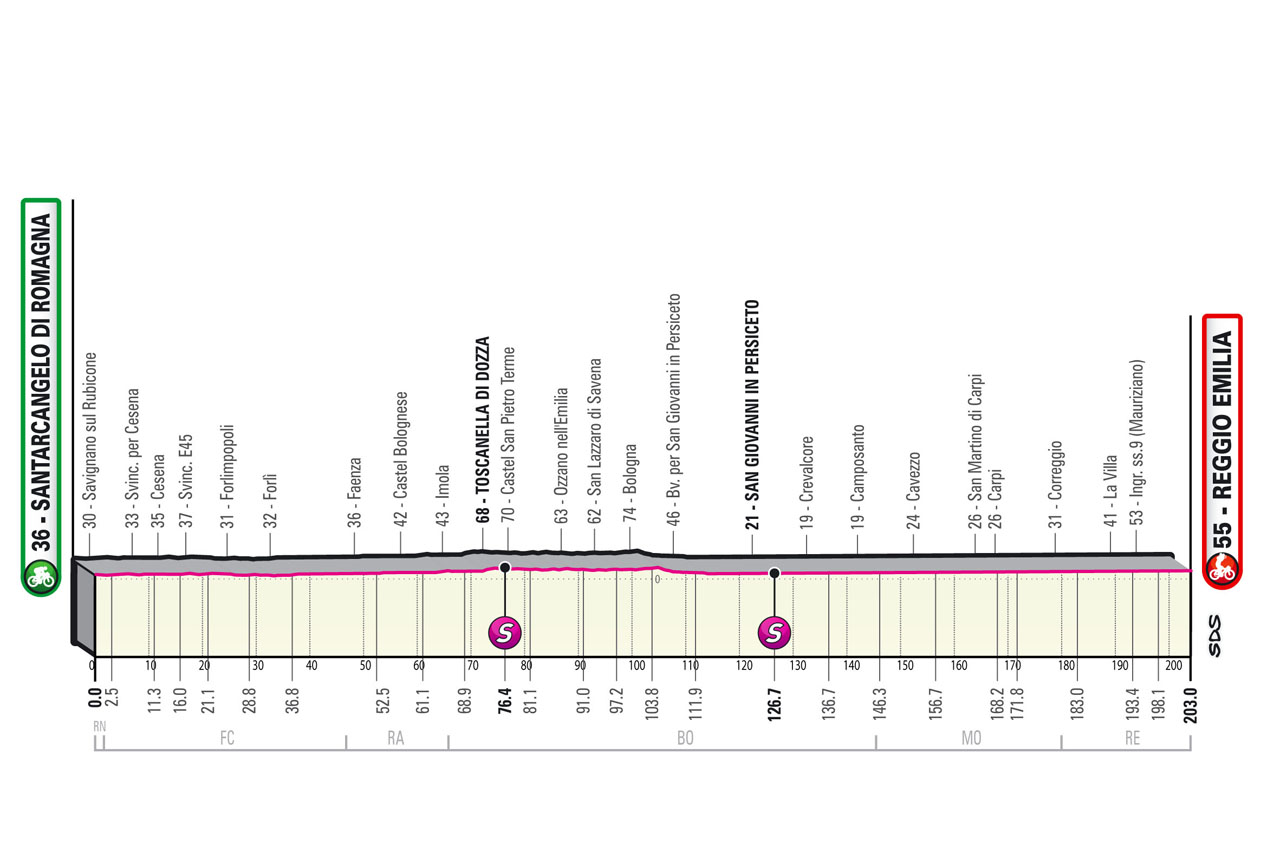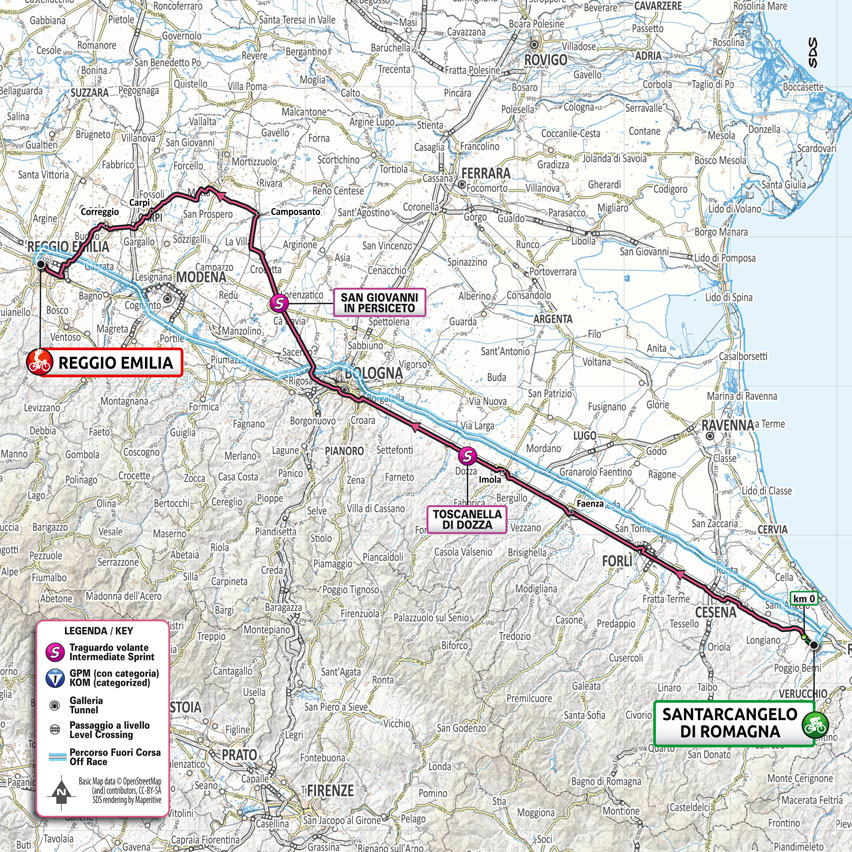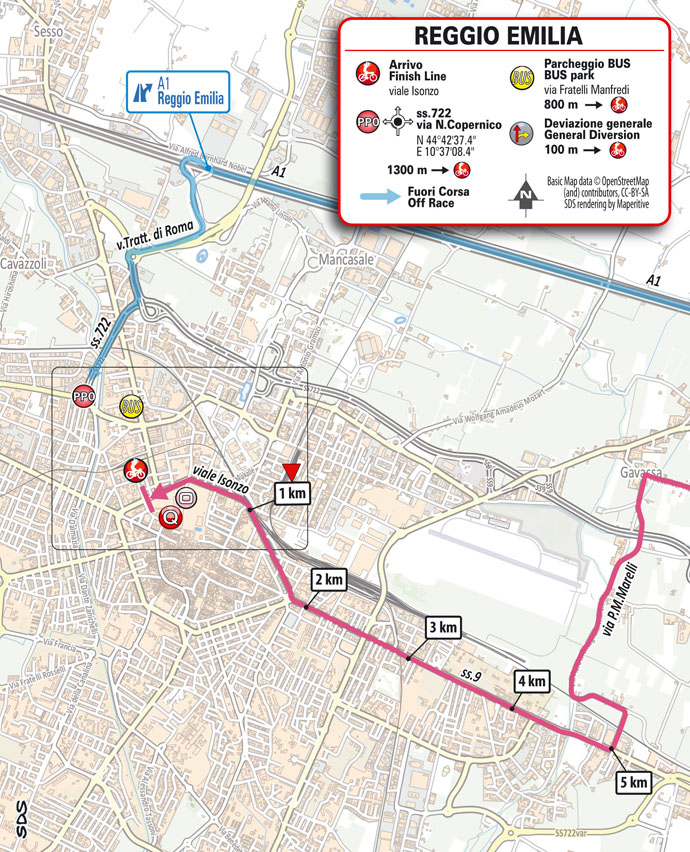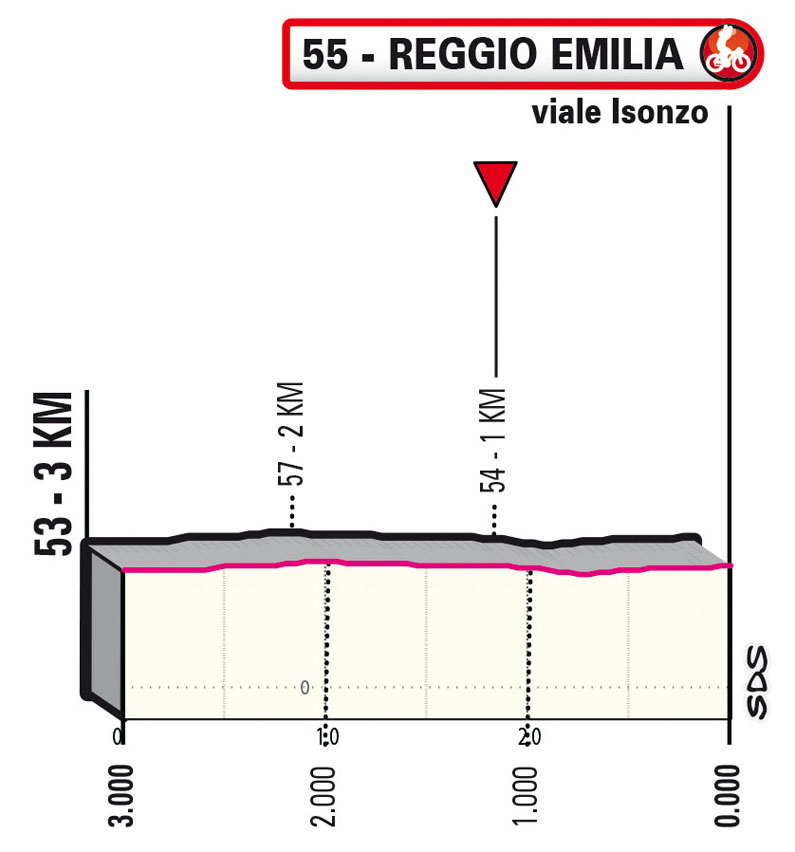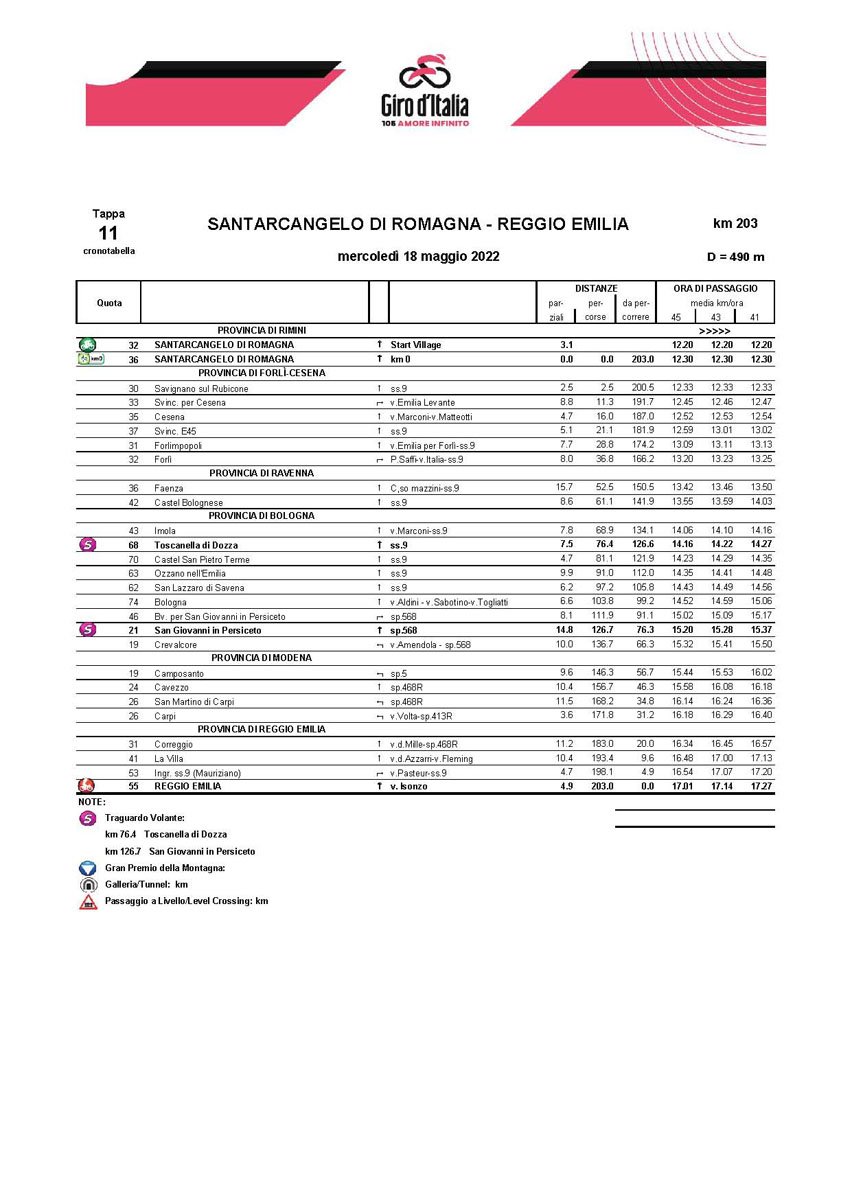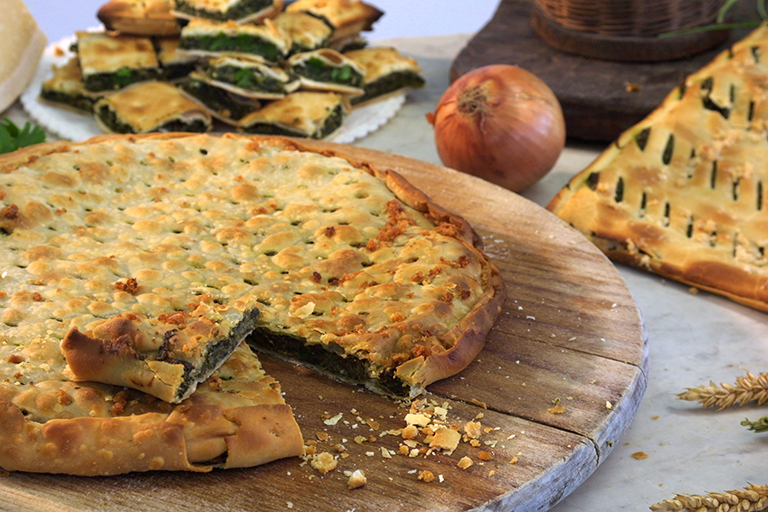profile
map
technical info
The route
A pan-flat stage across the lowlands of Emilia-Romagna, on straight and mostly wide roads. As the stage passes through several urban areas, roundabouts, traffic islands and street furniture will be found along the route.
Final kilometres
The final kilometres are on wide and well-surfaced roads, with roundabouts, traffic dividers, pedestrian islands and speed being the main obstacles. The home straight is 350 m long, on 7‑m wide tarmac.
start / finish
final kilometres
itinerary timetable
tourist info
Host city:
Santarcangelo di Romagna
Touristic Information
Santarcangelo di Romagna, Cittaslow, is considered as Portal to the Marecchia Valley, and the best place to discover the terrority’s enchanting medieval towns and incredible fortresses.
Walking through the fascinatingly, picturesque cobbled-stoned quarters, you are immediately struck by this old town’s magical charm, its warmth, the excellent quality of life and the welcoming hospitality of its people.
The old town, located on Jupiter Hill, is dominated by the imposing Fortress and the Civic tower. Its charm and character are embodied in the lively and colourful lanes, staircases and squares.
Santarcangelo is also a City of Art. For over 50 years it has hosted “Santarcangelo International Theatre Festival” (July) and it’s also well known for dialect poetry, with protagonists such as Tonino Guerra.
Many colourful, cultural events are held throughout the year, including centuries-old autumn festivals, “San Martino Fair” (November) and “San Michele Fair” (September).
Gastronomy
Santarcangelo is very famous for its gastronomy, offering excellent food and wine. Walking through the town’s lanes, you will find lots of restaurants, trattoria, taverns and piadinerie where you can enjoy truly mouth-watering, delicious cuisine from the local area. There are also many shops where you can buy locally produced food, typical to the area.
One interesting aspect of the local cuisine is the onion; many years ago, Santarcangelo was famous for its onions cultivated “from water”, so much so that the people from Rimini mocked them, calling them “Zvùléun”, “Cipolloni” or “Big Onions”.
This type of onion is still grown and is very tasty when eaten raw with radicchio, seasoned with local extra-virgin olive oil, coarse salt, Sangiovese wine vinegar and a grilled sausage in a steaming hot piadina. This is considered Santarcangelo’s typical ‘street food’ and is popular during the San Martino Fair.
Beverages
According to an old legend, hundreds of years ago, the town’s Franciscan monks were great produces of red wine.
One day, the convent organised a banquet in honour of a distinguished guest, offering him the best red wine from their cellar, as they were keen to make a good impression. The guest immediately wanted to know the name of this excellent wine.
After a moment of uncertainty, one of the monks suddenly stood up and exclaimed, “Sanguis Jovis” or “Sangue di Giove” (Jupiter’s Blood) thinking of the wine’s intense red colour and the name of Jupiter Hill, where Santarcangelo’s old town and the convent were located.
Over time, the two words joined together to become “Sangiovese” and the name spread throughout Romagna.
To confirm the legend, the Austrian glottologist Friedrich Schürr (1888–1980), Tribune of the Wines of Romagna, a great scholar of the Romagna language, confirmed that, following extensive research, the name “Sangiovese” derived from Jupiter Hill on which the magnificent medieval citadel of Santarcangelo was established.
Cardinal Ersilio Tonini, the well-known Archbishop from Ravenna, used to say that the people from Romagna are particularly devoted to only to one saint, San Giovese!
Main sights
The Caves – Below Santarcangelo lies a network of fascinating and mysterious caves, a truly amazing underground city. There are over 160 underground caves excavated into the eastern part of Jupiter Hill, many used as cellars for the conservation of wine and food, others for cult rituals.
City Museums – The Ethnographic Museum is dedicated to ancient crafts and folk traditions, while the Historical Archaeological Museum contains the town’s artistic heritage. The “World of Tonino Guerra” Museum is dedicated to the famous screenwriter and poet, while the Button Museum houses an amazing collection of thousands of buttons, each one telling a story.
Marchi Family’s Antique Printing Shop – A workshop where fabrics are still printed using special techniques and rust coloured ink, observing a very old and tradition. The extraordinary Mangano (or huge rotary iron), still used for ironing the canvas, dates back to the 17th century.
Malatesta Fortress – Today, this impressive fortress is the residence the noble family, Colonna di Paliano. Since 1447, when Sigismondo Pandolfo Malatesta rebuilt the Castle to resist attacks and bombing, it has remained more or less the same.
Collegiata Church – The town’s main church was completed in 1758 by architect Buonamici from Rimini. It houses numerous works of art including a crucifix by the 14th century Giotto School in Rimini and an altarpiece by painter Guido Cagnacci, born in Santarcangelo.
Ganganelli Arch – This Triumphal Arch, at the entrance to Ganganelli Square, was built to honour Pope Clement XIV (1705–1774), born in Santarcangelo. Every November, large horns are suspended from the Arch in occasion of the San Martino Fair. Local tradition has it, that if they swing or move as you walk under the Arch, then you have been betrayed in love.
Pieve of San Michele Arcangelo – It is the oldest religious building in town and surrounding area, built by Byzantine masons, and partly inspired by the great contemporary models of Ravenna. The Pieve still contains elements dating back to its origins, some of which remain a mystery.
Bell Tower – Built towards the end of 1800s, the 25metre tall Bell Tower is situated in the heart of the old town and is a symbol of Santarcangelo, known by the locals as the “Big Bell”.
Porta Cervese – This entrance into the town is known as the “Salt Gate” because it connects Santarcangelo to the road leading to Cervia’s salt pans. Now it remains the only access to the second Malatesta wall of the city.
Sferisterium – This rectangular playing field is located beneath the Malatesta walls. Originally, it was used for playing a traditional ball game with a wooden arm-brace (pallone al bracciale). Today, it is still used for another traditional game, tamburello, played with a tambourine-like bat.
Mutonia – The Mutoid Waste Company, a community of English artists, came to Santarcangelo in the 1990 to participate in the International Theatre Festival. They settled near the Marecchia River, where they created a magical place with their unique sculptures made with urban waste.
Reggio Emilia
Touristic Information
Located in the Po River Valley, Reggio Emilia is known as the Town of the Tricolour because here, in 1797, the banner – which later became the national flag – was officially adopted.
Known today for its gastronomy, for the quality of life and, internationally, for the “most beautiful kindergartens in the world”, Reggio Emilia is also a town of art: some of the most important personalities in Italian history were born here, such as the great Countess Matilde di Canossa, the poets Matteo Maria Boiardo, Ludovico Ariosto, the painter Antonio Allegri known as Correggio and the photographer Luigi Ghirri. Reggio Emilia is also a town with a strong artisan and industrial vocation. Many of the buildings that bear witness to this have been the subject of skilful interventions of industrial archeology and now host some of the most important excellences of the area in the industrial, educational and cultural fields. The Bridges and the Calatrava high-speed railway station welcome the visitor: the new access gates to the town, with their sinuous and light shapes, present the Reggio Emilia of the XXI century: a lively town, full of festivals – as European Photography – and artistic works.
Gastronomy
The creativity of the Reggio Emilia cuisine has mainly developed in the first courses: the king of first courses, that is cappelletto in broth; tortelli: filled with pumpkin, typical of the Po River plain, or green, with a filling of chard and spinach; green lasagna, rice bomb and homemade tagliatelle, which in the mountains area are served with mushrooms sauce. For starters: Erbazzone Reggiano, the most characteristic culinary production of Reggio Emilia, deserves a special mention; it is a salted pie made with spinach or chard, Parmigiano Reggiano cheese and onion. Born as a poor dish, prepared with food leftovers and improved with the excellence of our land, the Erbazzone accompanies Reggio Emilia people at both any time of the day and on holidays. Not to be missed are Parmigiano Reggiano cheese, properly called the King of Cheeses, and two drops of Reggio Emilia Traditional Balsamic Vinegar: refined flavours for demanding tastes.
Beverages
Since ancient times, the Romans knew the oenological vocation of the Reggio Emilia land and appreciated the Lambrusco vine. The clusters of that vine still give birth to a sparkling wine, which has always accompanied the first and second courses of traditional Reggio Emilia cuisine. In the red or rosé, dry or sweet variants, Lambrusco is now one of the best known and appreciated – as well as exported – Italian wines in the world. For lovers of white wines, the Colli di Scandiano and Canossa Spergola PDO will surprise you: an ancient vine, only recently rediscovered and appreciated, it is perfect as a cocktail and also to combine desserts. At the end of the meal, a glass of Nocino (nut liqueur) is never missing: it is an ancient liqueur linked to popular tradition, prepared with walnuts collected on St. John’s night.
Main sights
The discovery of the town centre will start from the Tricolour Flag Hall and its Museum, which traces the history of the Italian flag with Napoleonic and Resurgence relics, to continue in the facing Piazza Prampolini, better known as Piazza Grande (Big Square), overlooked by the Cathedral and the Baptistery. Through the arcades of the Broletto, former garden of the canons, you reach Piazza San Prospero, characterized by the church dedicated to the Patron Saint and by its characteristic lions, symbol of the town. Continue along Via San Carlo to Piazza Fontanesi, a real outdoor “living room” surrounded by trees, the perfect place for a relaxing break or dinner with friends. Going along Corso Garibaldi, formerly the Crostolo stream bed, you arrive at the Basilica della Ghiara, a wonderful example of the Emilian Baroque style, which hosts precious works of art such as the Crucifixion by Guercino, as well as a cycle of frescoes on the female figures of the Old Testament. Continuing along the Via Emilia, the main street of the town centre, you reach the cultural heart of the town: many museums and theatres overlook Piazza Martiri del 7 luglio and Piazza della Vittoria. The renovated Museums Palace stands out for its naturalistic, art and archaeology collections; the Parmeggiani Gallery is an eclectic XIX-century museum house; the Synagogue and the Jewish ghetto bear witness to a piece of Reggio Emilia’s history; the neoclassical and majestic Valli Municipal Theatre dominates the square with its new fountain. Contemporary art has enriched many corners of the town: from Spazio Gerra to the works of Invitation to, from contemporary art in the Cathedral to the amazing Maramotti Collection, which exhibits works of inestimable value from the second half of the Italian and international XX century. In the town centre are Palazzo Magnani, the main exhibition venue – that organizes and hosts exhibitions – , as well as the recently renovated San Pietro Cloisters, that are one of the most important locations for events and cultural life. The RCF Campovolo Arena, the largest arena for shows and concerts in Italy, will soon be inaugurated.
Just 20 km away, on the lower hills of Reggio Emilia, do not miss a visit to the Matildic Castles of Canossa, Rossena and Bianello, Sarzano and Carpineti; obligatory stop also at the Bismantua Rock, an extraordinary rocky conformation symbol of the Reggio Emilia Apennines. In Gattatico the Cervi Museum offers a look at recent history, made up of commitment and resistance.































